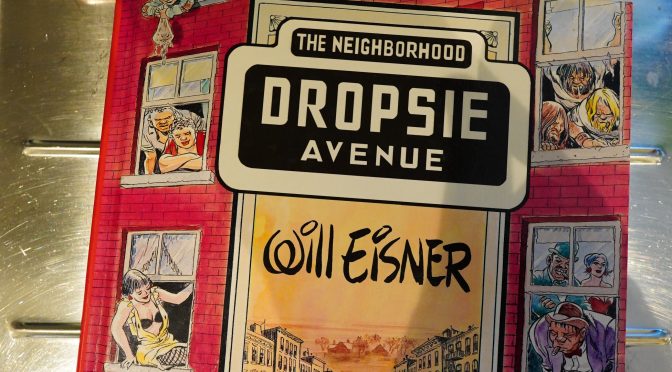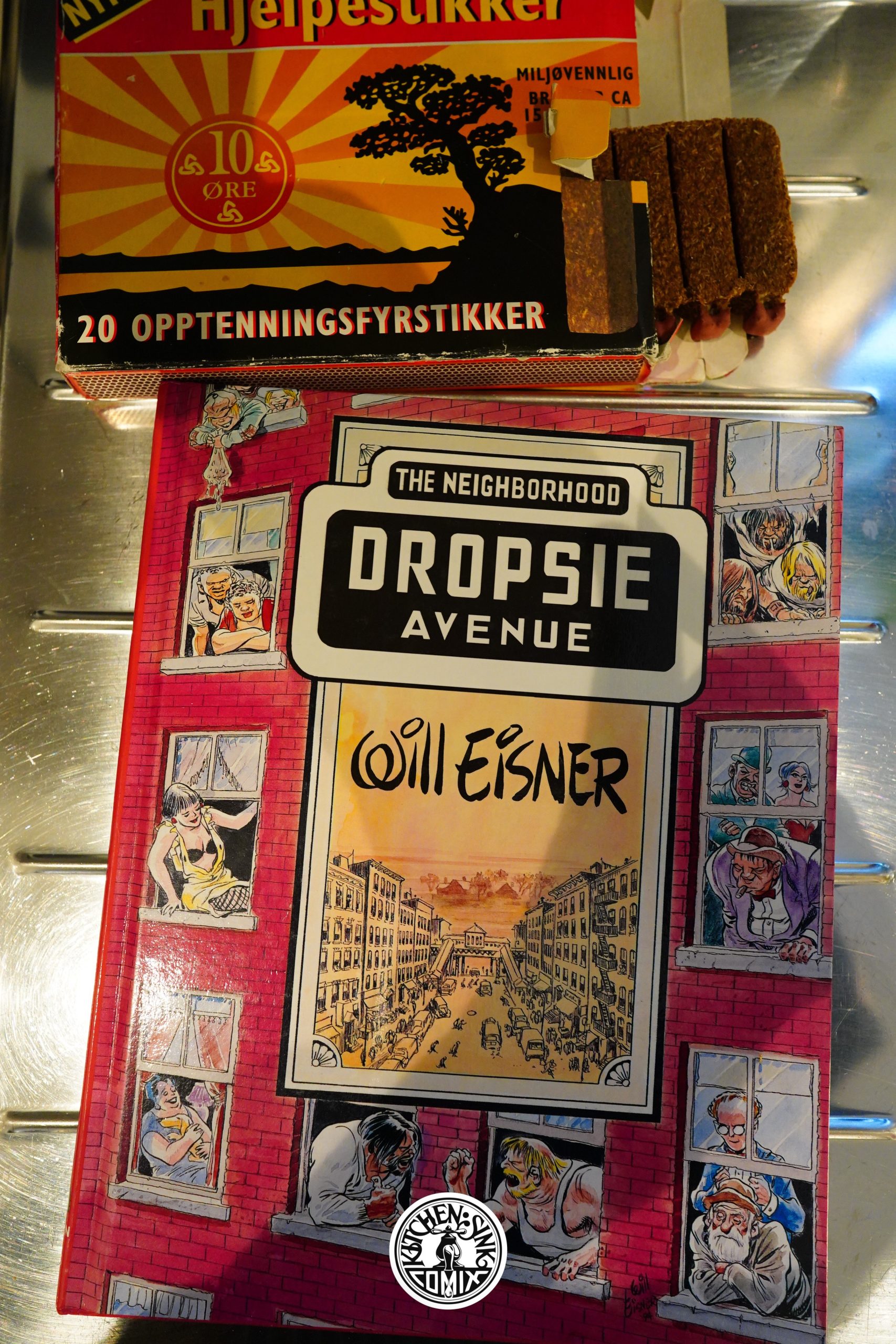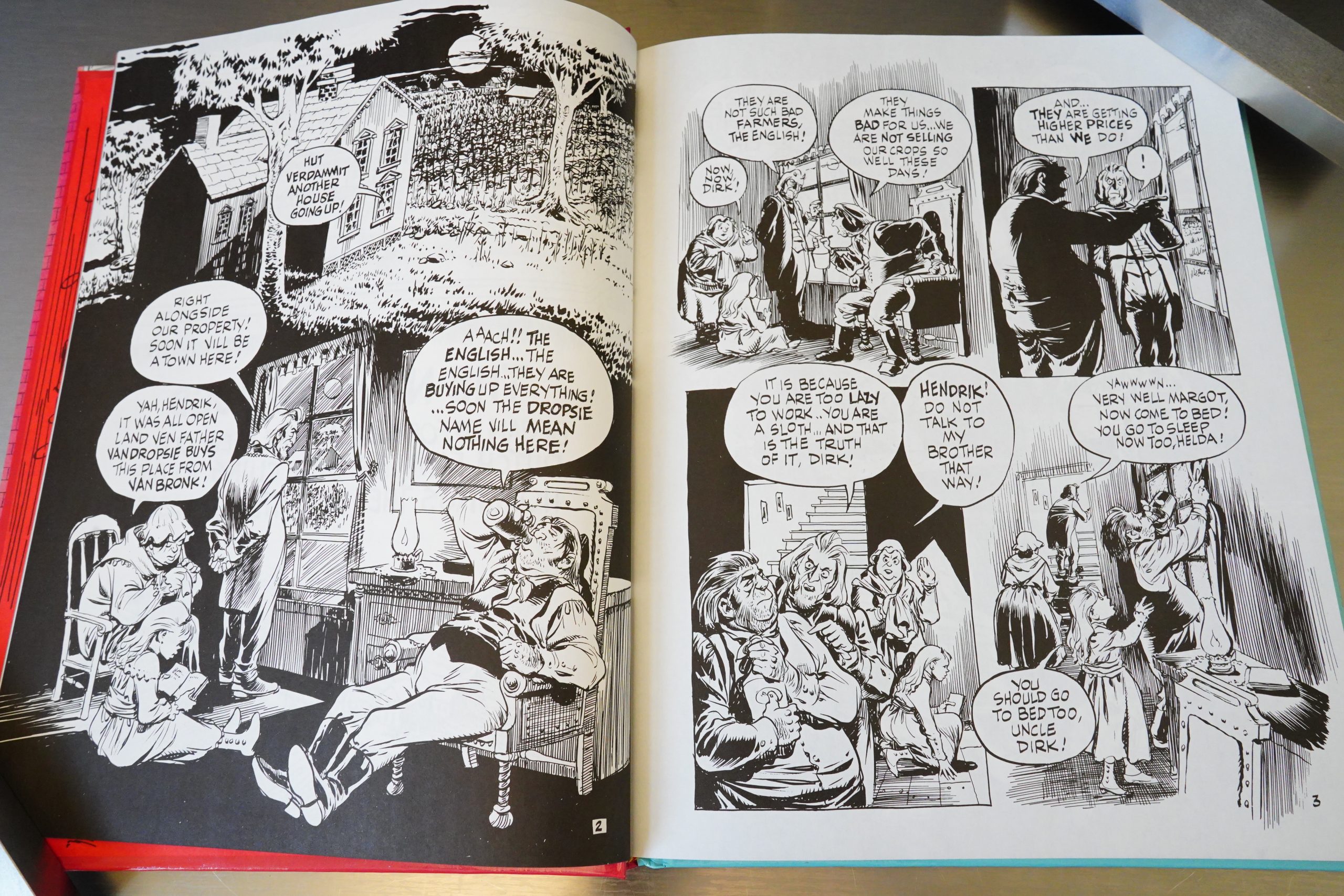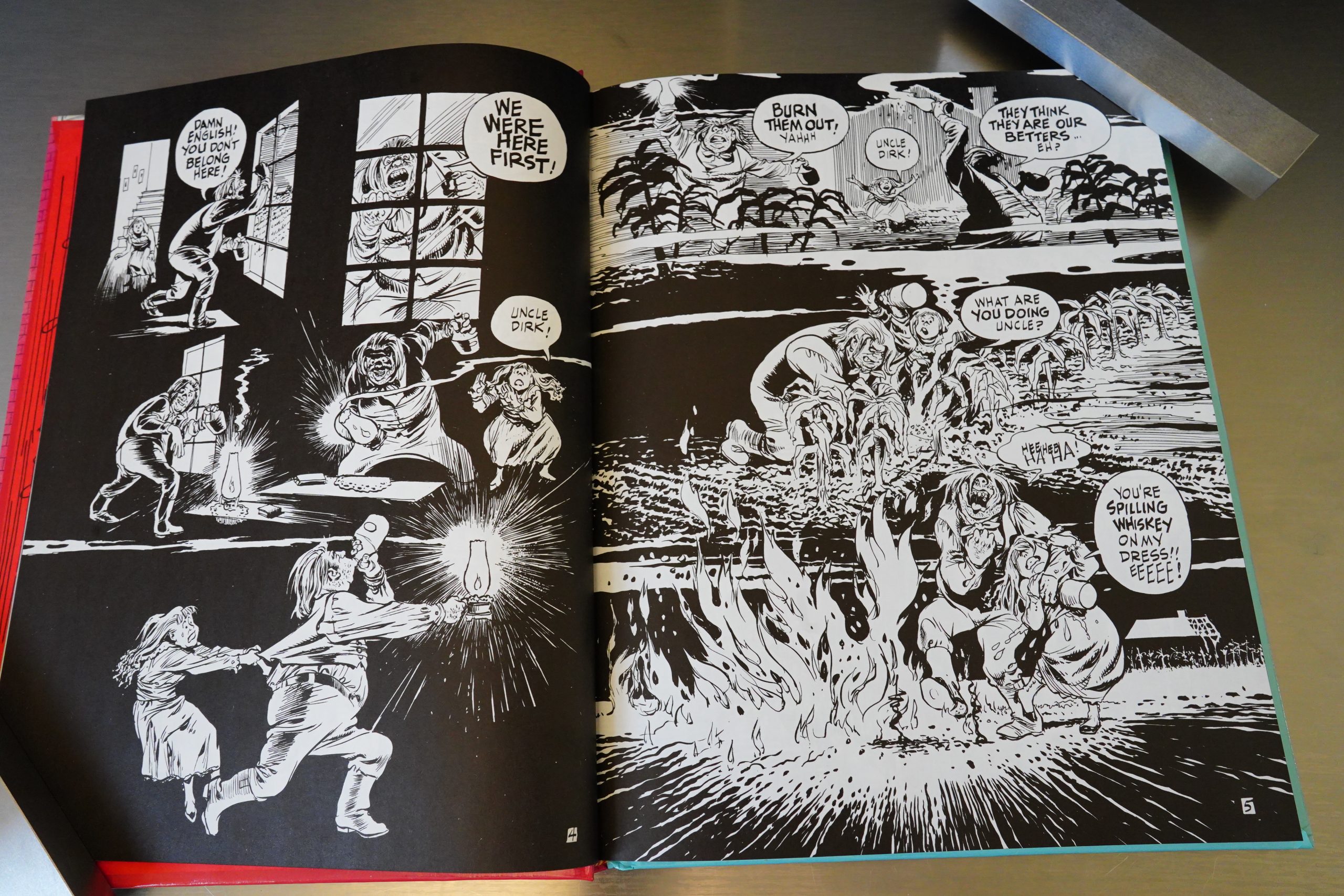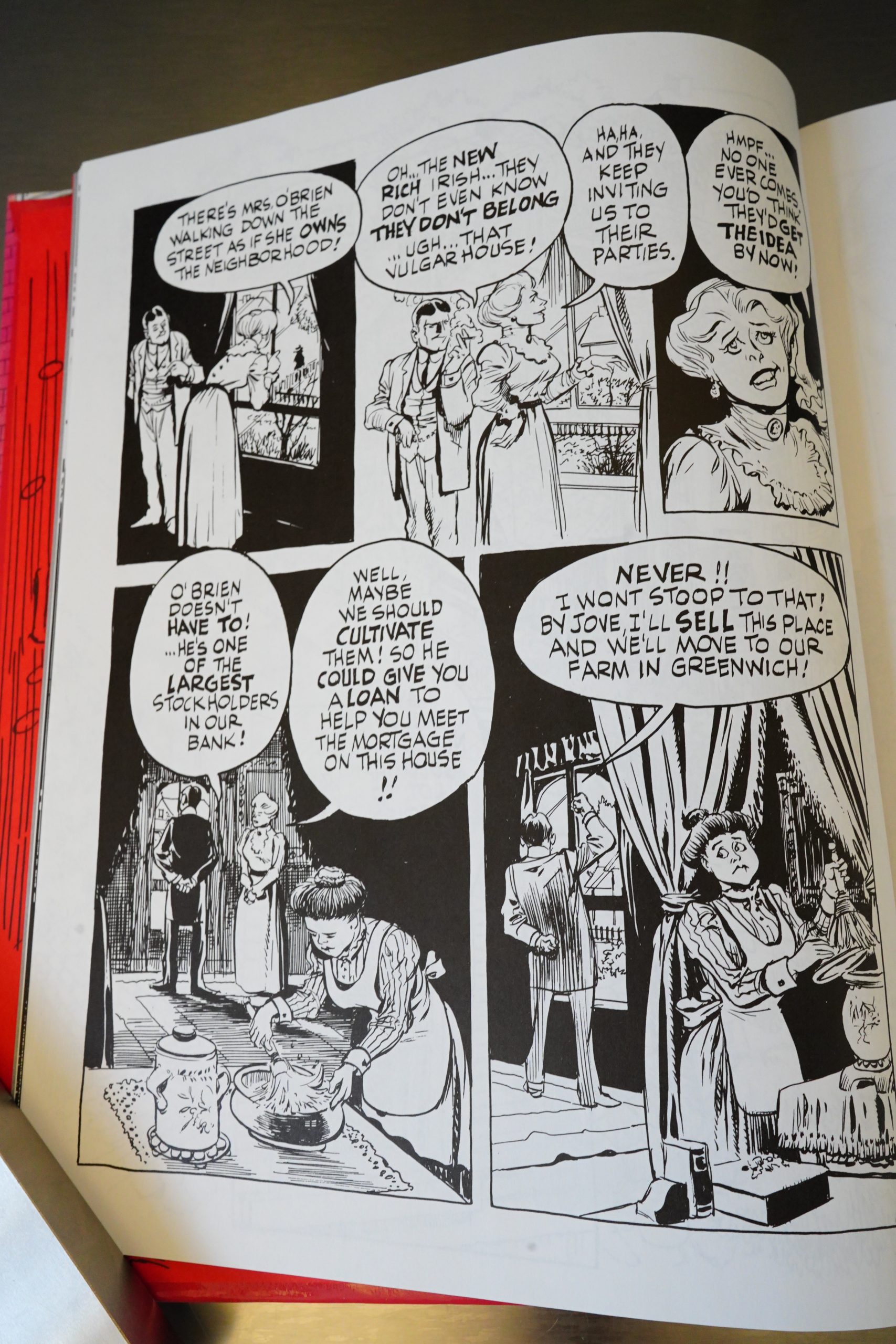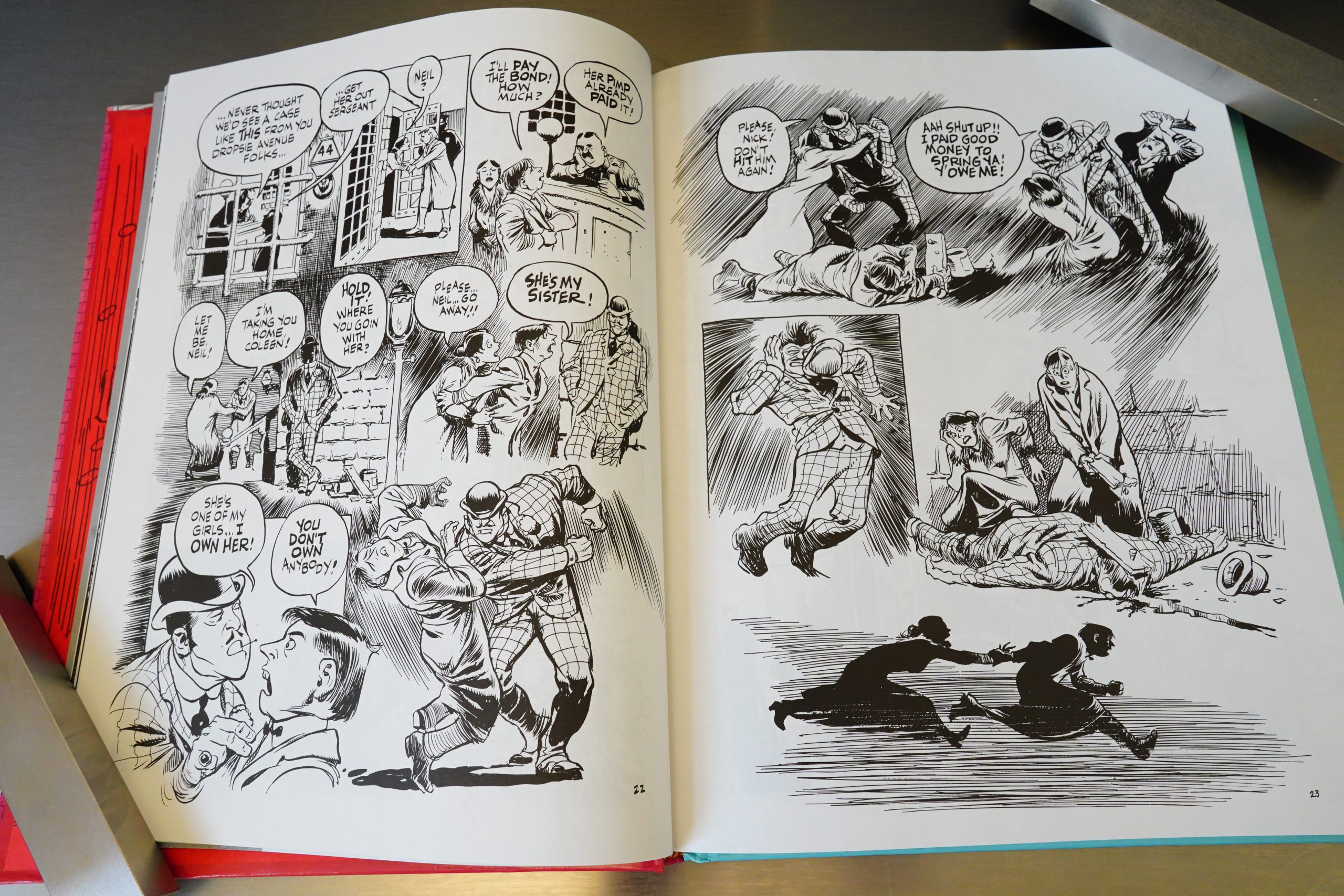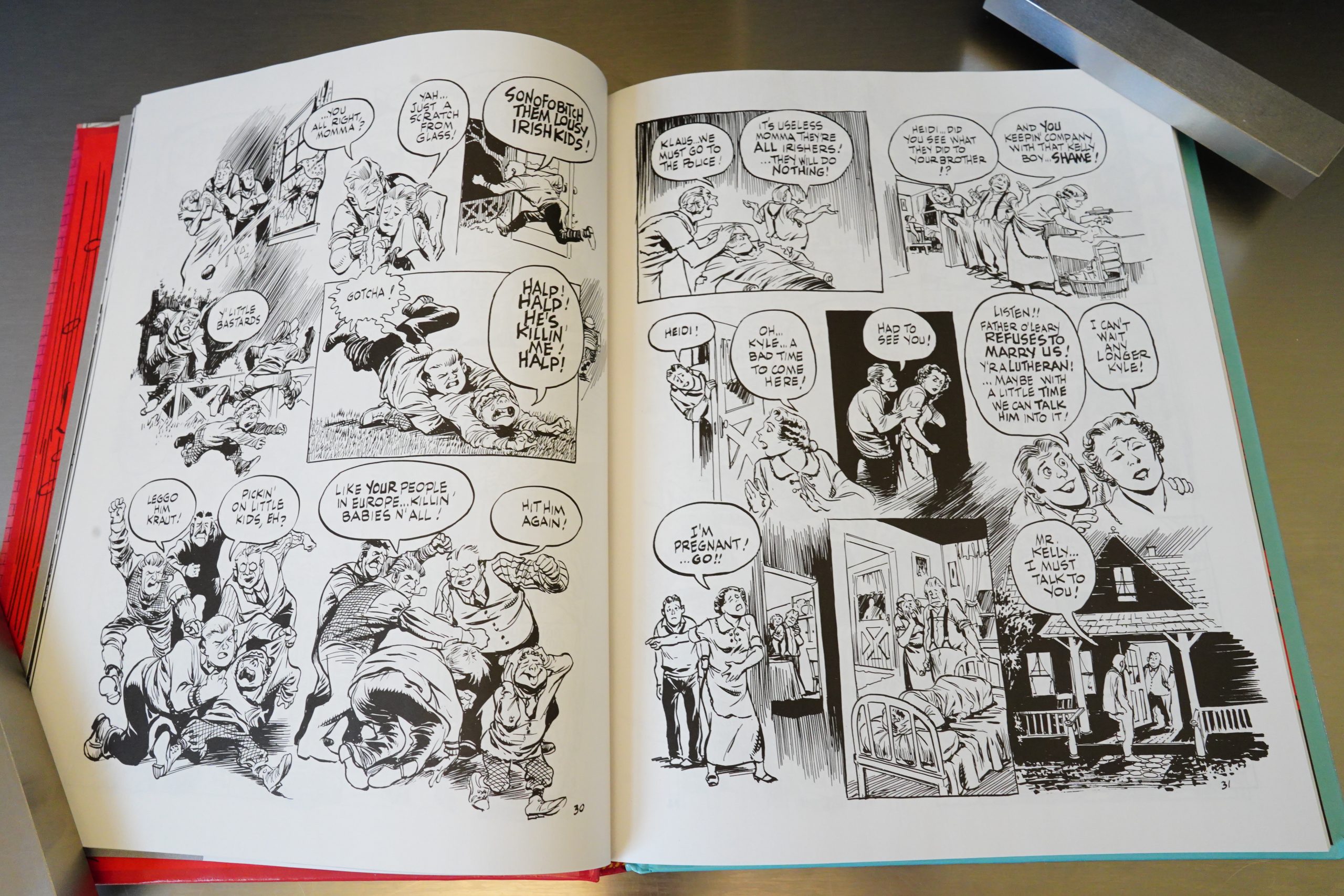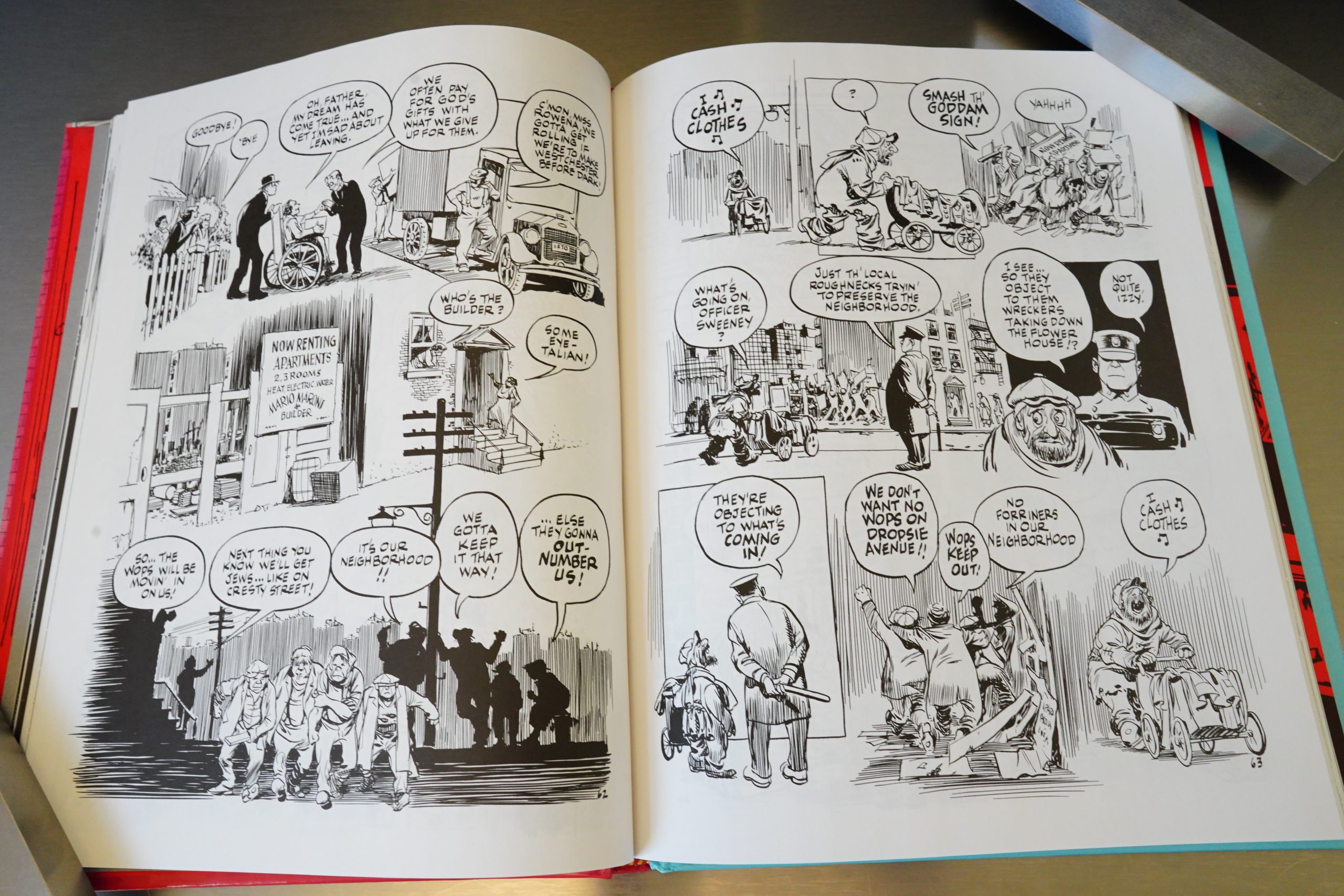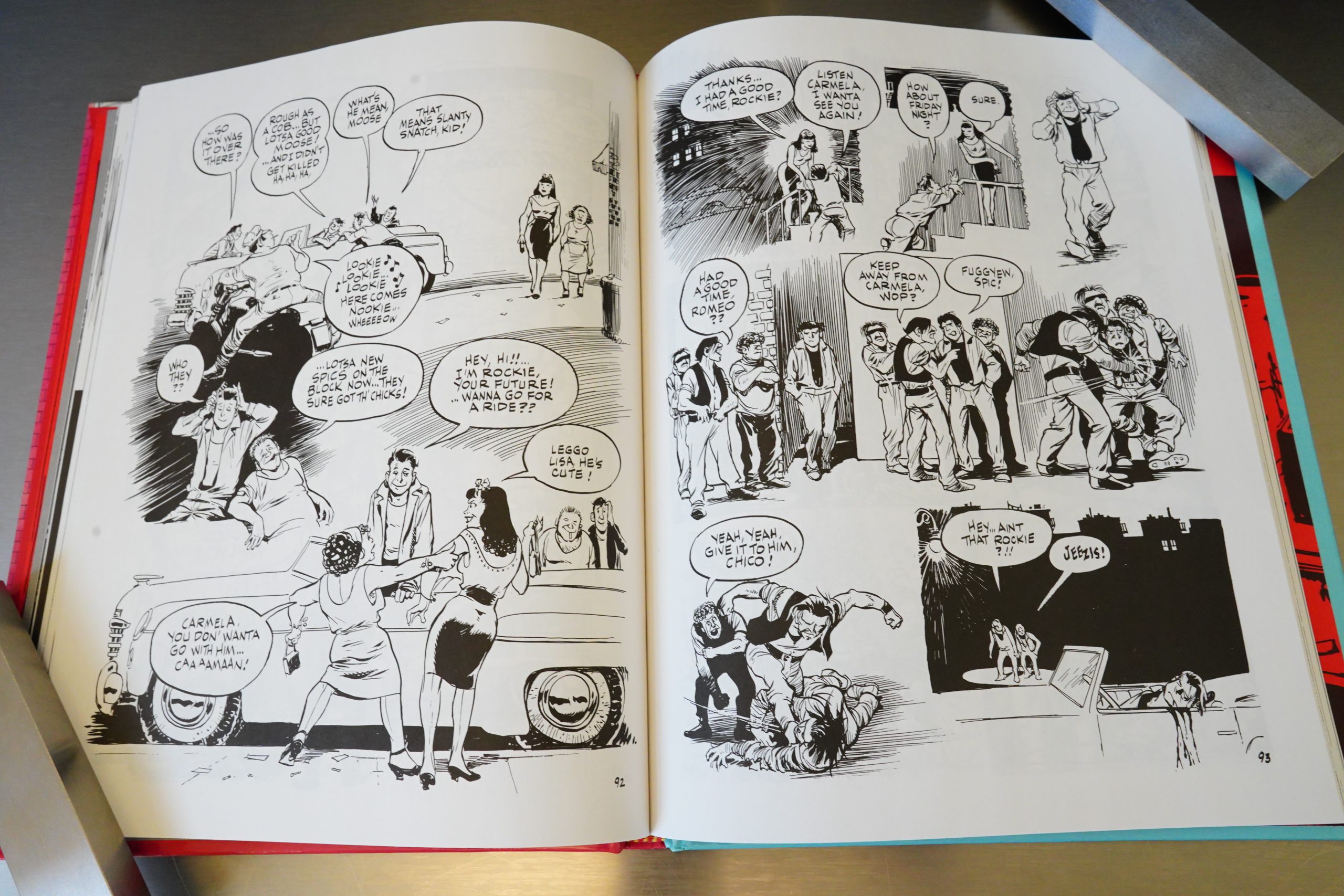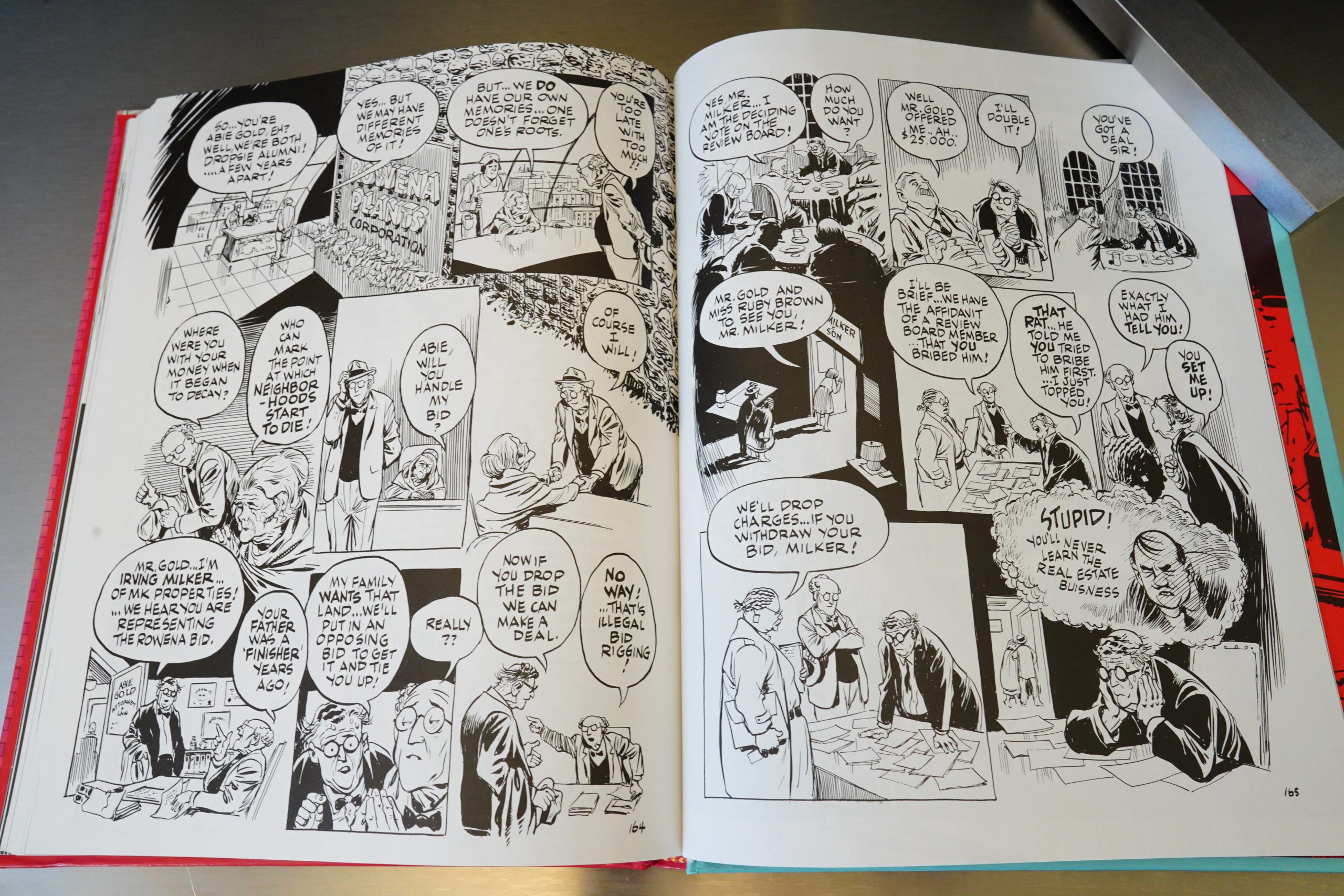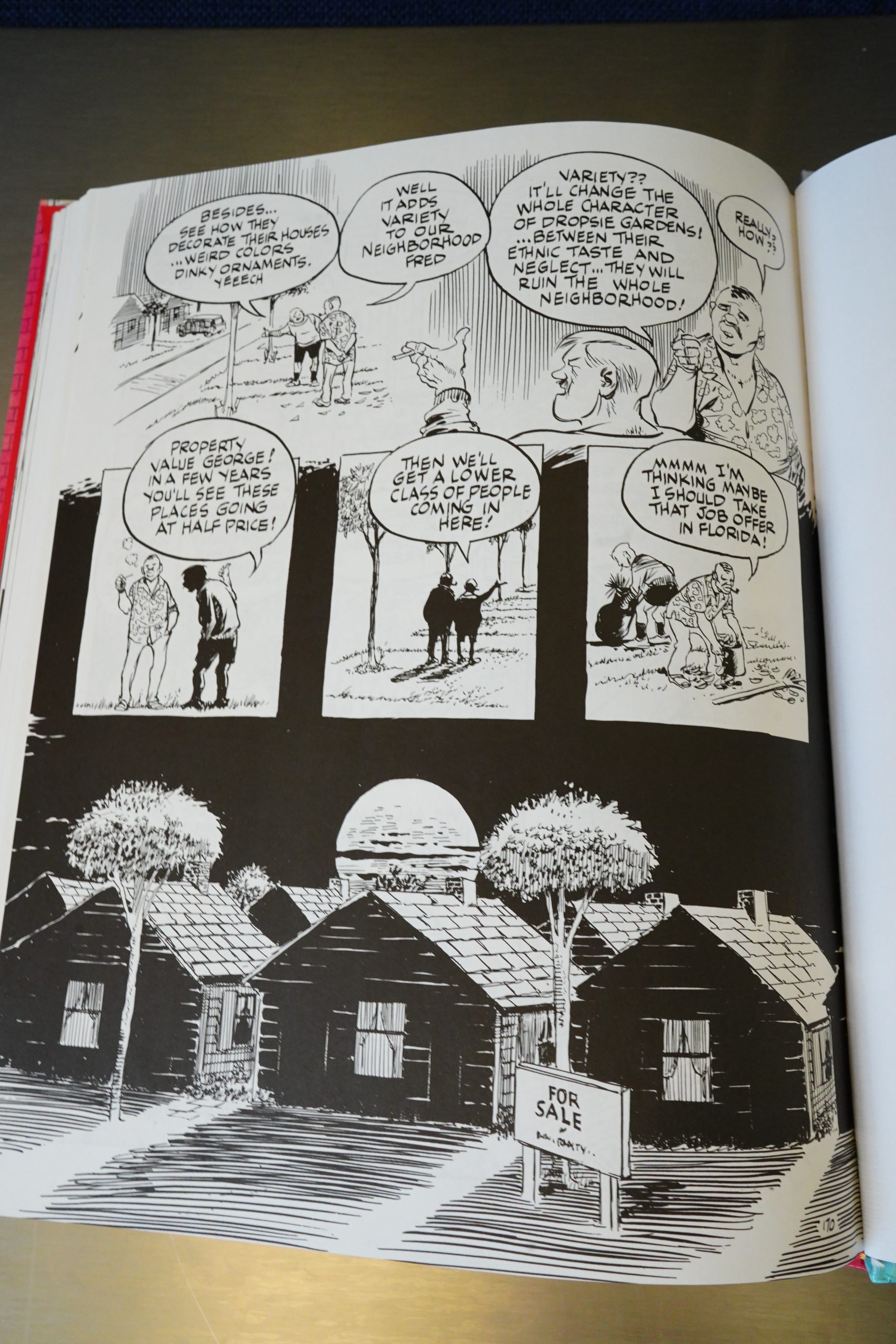Dropsie Avenue: The Neighborhood (1995) by Will Eisner
Eisner returns to Dropsie Avenue, the fictional equivalent of the neighbourhood he grew up in, but this time he tells the full history of the neighbourhood, starting from when it was farm country. But… hasn’t he already done this? I seem to remember a shorter piece with the same premise? So this is an expanded version of that.
And, once again, Eisner’s theme is that every generation sees the next generation as low-down encroaching riff-raff, from the Germans looking down on the English on. And as usual, when Eisner has a theme, he hammers it home.
Eisner isn’t much for subtlety in general.
So we get this repeated over and over, being very ironic: New people move in, the older generation moves to greener pastures.
It’s a 160 page book, but it covers more than a century, so we don’t get many pages per character — especially in the first half. That leaves us with a bunch of these vignettes without having any impetus to care about what happens, and it makes for tedious reading. The first half of this book may be Eisner’s most exquisitely boring work ever. It’s a pain to get through, and I almost ditched the book.
Eisner was about 80 when he did this book, so I guess you can’t blame him for doing retreads. But the art’s as accomplished as ever, even if he’s not as extravagant with his layouts as earlier. Within the straitjacket of his concept, the storytelling is very smooth.
The cops are the worst.
We get a shift around the half-way point of the book (which coincides with the timeline catching up with Eisner’s own life). Eisner starts introducing more interesting characters, and we start following their wheelings and dealings over the decades, and the book actually starts becoming rather interesting.
But, as ever, we return to The Theme.
There’s only a single population shift that Eisner portrays as being rather civilised — when Black characters move in from the South, the Jewish population is kinda cool about it.
By the end of the book, I found myself rather gripped by the story — totally unexpectedly, scenes like this started having an emotional impact.
And we end on the requisite ironic note. OOPS SPOILERS
So — this was a lot better than I had expected, but the first half of the book is tough sledding.
Bill Skelly writes in The Comics Journal #183, page 42:
Dropsie A venue: The Neighborhood begins
with a nine-page sequence that is as perfectly
conceived and executed as anything Eisner has
ever crafted. In 1870, the Van Dropsie family
(descendants of the original Dutch settlers)
bemoans the division of the remaining small
farms into lots. A drunken uncle rages into the
night against the English newcomers. and acci-
dentally sets fire to his young niece. This pow-
erful opening segment, which ends with the
dead girl’ s father exacting immediatejustice on
the uncle, is both shocking in its sudden vio-
lence and
sublime in its
economy.
Uhm… I’m guessing the author here has never seen a 30s B movie melodrama?
The Comics Journal #183, page 44:
Eisner’s principal challenge in tracing the
125-year history of a single community in-
volved finding story-telling strategies to com-
press the timespan into 170 pages while still
involving the reader in well-defined characters
and situations. Typically, he rejects the obvious
method of creating text-laden chapter di visions
to easily delineate the passage of time and fill in
the narrative gaps. Nor does he rely on captions
— there are only a handful of captions in the
entire book. To his credit, Eisner effectively
weaves the indicators of the passage of time
(and other expository material) into the flow of
the pages, which average five or six panels
each.
A word about these page layouts: they are
largely without standard panel borders, yet the
eye is directed through the page, from image to
image, without hesitation. Unlike so many
mainstream comics of today, one never has to
pause to decide which panel to read next. When
you consider the complexity of Eisner’s pages’
it becomes apparent that his mastery of the
form, at 77 years Of age, has reached near
perfection.
In Dropsie A venue, as in his other graphic
novels. substance is more important than style.[…]
Up to that point, it seems to me, the author
has shown us that individuals motivated by
greed will overpower those well-meaning souls
who seek to preserve a neighborhood’ s quality
of life. One might wish for a happier conclu-
sion, and it’s true that Eisner tacks onanequivo-
cal twist at the very end rather than expect us to
swallow the sugar straight; but, one can’t help
but go back to his original unvarnished state-
ment: “Neighborhoods have life spans. They
begin, evolve, mature and die.” Had his narra-
tive adhered to this statement, the death of
Dropsie Avenue would have had a power only
suggested, finally, by the image on the back
cover of the book, which resembles nothing so
much as a bombed-out war-zone.
Even with that sort of uncompromising
ending, the book wouldn’t be a total bummer.
For if no particular action or group of actions
could have permanently halted the decline of
a neighborhood, Eisner’s dramatization of
some of the positive moments that derive from
the community pulling together offers a kind
of inspiration. The best example that comes to
mind is the moment when Father Gianelli and
Rabbi Goodstein surprisingly agree to preside
over an inter-faith wedding. Though the fami-
lies are at first skeptical, the union of an Italian
girl and a Jewish boy gives Dropsie Avenue
one of its finest moments. The marriage stays
together, and the two families find an accom-
modation. Ethnic tensions in the area are tem-
porarily eased. Eisner knows how to deepen a
story by using the unexpected. There is hope in
the inner city.
Paul J Grant writes in The Comics Journal #177, page 32:
With Dropsie Avenue, his latest graphic
novel, Will Eisner returns again to the ficti-
tious Bronx neighborhood he first introduced
in 1978’s A Contract with God. However,
where his previous works used the locale as a
backdrop against which human stories were
enacted, this time the human stories serve to
delineate the story of the gradual corruption
and destruction of the urban microcosm
known as the South Bronx. This time, the
street is the main character, as it weathers
120 years of change.[…]
Some will doubtless read Dropsie Avenue
and accuse Eisner of resorting to ethnic ste-
reotypes. This is a criticism he not only un-
derstands, but welcomes: “I have a very
strong feeling about stereotypes. It is almost
impossible to function in this medium with-
out the use of stereotypes, which are a very
important part of the language of the me-
dium. Without the use of stereotypes, you
cannot successfully achieve instant recogni-
tion of a charactev So I have absolutely no
apology.”
Eisner has also been accused of sentimen-
talizing the past in earlier works. Although
there are many sentimental parts in Dropsie
Avenue, the novel has a hard, cynical edge.
Eisner concedes that this work was largely
fueled by his anger. “Asl got into this thing,
the more I realized there was a lot of inexcus-
able greed and moral corruption that goes
into the destruction of the neighborhood. The
whole point of doing a book like this is to
show the disintegration is not physical, but
rather a result of human dynamics… an inter-
nal force.”[…]
Dropsie Avenue is powerful stuff,
wrenched from real-life events, and a far cry
from the typical comics fare. When asked
who he sees as his target audience, Eisner
laughs and replies, “Whenever I’m asked
this, I always say my reader is a 40-year-old
man who’s just had his wallet stolen in a sub-
way in New York.” He continues, on a more
serious note. “I’m addressing myself not so
much to an age group but to a group of
people who have similar experiences and can
understand what I’m saying. Certainly, I can-
not expect a callow youngster who has had
maybe 12 to 15 years of life experiences,
whose life has centered around MTV, to be
interested in the disintegration of a neighbor-
hood or be concerned about why it disinte-
grates. But there are things one can do in this
medium to raise the level of the storytelling
to reach the intellect of the reader. I’m con-
sciously trying, in my work, to make contact
in a context with the internal emotions of
people.”
The art was terrific, but the storytelling quickly became repetitive. Okay, I get the idea — each group that lives in this part of the Bronx thinks that it is better than the newcomers and the neighborhood slowly gets worse and worse. But because we are going through decades, we don’t have any characters to follow, and it quickly just becomes the same thing over and over again, with differently dressed ethnic types despising each other. Feh!
Unexpectedly negative review from PW:
Even his virtuoso draughtsmanship and composition appear to have ossified into self-imitation and pictorial cliche. Despite his obvious affection for urban life, Eisner reduces decades of social patterns to unsatisfying, symbolic characterizations that awkwardly represent an era, rather than embodying genuinely wrought, particularized human interaction.
This is the one hundred and eighty-second post in the Entire Kitchen Sink blog series.
